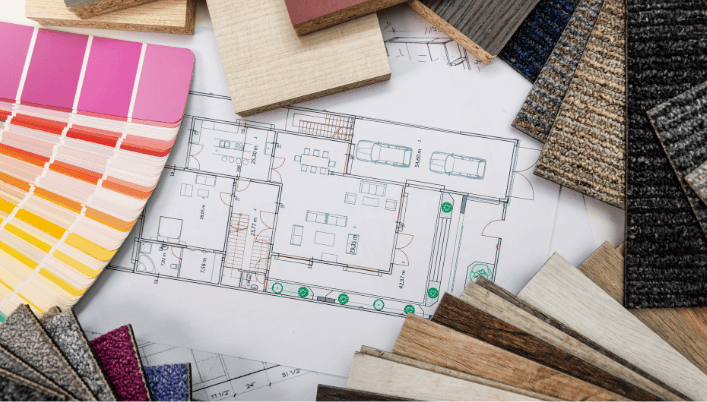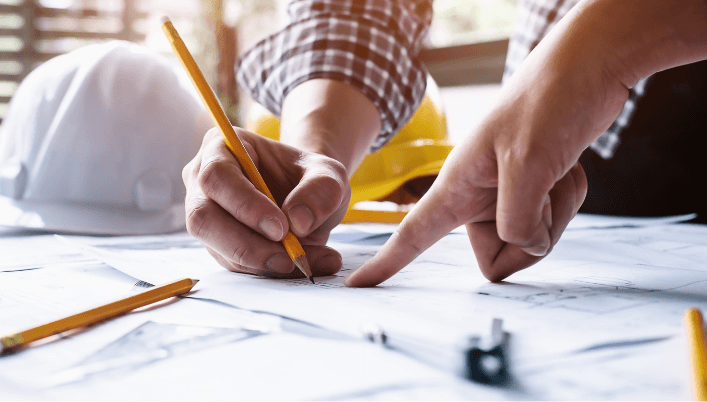Overview of Floor Plans in Singapore

What is a Floor Plan and Its Importance in Designing Spaces
A floor plan is a visual representation of a space, showing the layout and structure of a property.
It provides a comprehensive collection of information about the rooms, walls, windows, doors, and other structural elements.
Floor plans are essential in interior design and real estate as they help in visualizing and planning the use of space.
When designing a space, a floor plan serves as a blueprint that outlines the arrangement of furniture, appliances, and other elements.
It helps in determining the flow of movement within a room and ensures that there is optimal use of space.
In Singapore, floor plans are particularly important for condominiums and HDB flats.
Buyers can refer to the original floor plan to understand the layout and make informed decisions about remodeling and renovations.
Developers also show provide floor plans to showcase the features and amenities of the property.
How to Read a Floor Plan and Understand the Symbols Used
Reading a floor plan involves interpreting the symbols used to represent various elements. Symbols in a floor plan indicate the position of walls, windows, doors, and other features. Key elements to pay attention to include bold lines for walls, black lines for doors, hollow lines for windows, and quarter circles to represent swing doors.
Understanding the symbols in a floor plan allows owners, property agents, and previous owners to visualize the space and plan their interior design and furniture layout accordingly. It is also helpful for architects and designers to communicate their ideas effectively.
Key Features of Floor Plans in Singapore
In Singapore, floor plans for residential properties often include specific features and amenities. These can range from the size and layout of rooms to the presence of windows and doors. Renovation plans may also be included to showcase proposed changes.
For HDB flats, floor plans indicate the placement of structural walls, swing doors, and casement windows. These details are crucial for remodeling or renovation purposes. In private residential properties, floor plans may also showcase the location of top-hung windows and various other features.
Floor plans in Singapore provide valuable information to homeowners, buyers, and developers. They allow for better understanding and visualization of space, enabling efficient and effective interior design and property management.
Key Takeaways
- Floor Plan Importance: Visual representation aiding in space design and remodeling decisions. Crucial for condos and HDB flats in Singapore.
- Reading Floor Plans: Understanding symbols like bold lines for walls, black lines for doors, and hollow lines for windows.
- Key Features in Singapore: Floor plans highlight structural details, renovation plans, and specific features for various residential properties.
- Floor Plan Software: Essential for designing spaces. Allows for 2D and 3D visualization, experimenting with layouts, and making informed design decisions.
- Creating 2D Floor Plans: Utilizing user-friendly tools for precise measurements, customization, and accurate representation.
- Optimizing Space in Floor Plans: Interior design tips include considering room functions, maximizing natural light, and exploring open-concept layouts.
- Using Templates and Real Estate Trends: Utilizing templates for efficiency and staying updated on real estate trends for functional floor plans.
- Exploring 3D Floor Plans: Offers precision, immersive experiences, showcases unique features, and allows for versatile layout options.
- Role in Selling or Renting: Crucial in Singapore’s real estate market, especially for HDB flats. Transparency in property features and layouts.
- Floor Plan Creator Tools: Various software options available for creating detailed and accurate floor plans. Understanding how to use them enhances space planning.
Creating Floor Plan Software / Space

Using Floor Plan Software to Design Your Space
Creating a floor plan for your space is an essential step in any interior design or real estate project.
With the help of floor plan software, you can easily create accurate and professional-looking floor plans in both 2D and 3D.
This technology allows you to visualize your space, experiment with different layouts, furniture arrangements, and décor choices before making any physical changes.
Floor plan software provides you with a range of tools and features that make the design process user-friendly and efficient.
You can input the measurements of your space, drag and drop furniture and room elements, and add detailed symbols to represent various objects and fixtures.
This allows you to create a comprehensive and realistic representation of your space.
Floor plan creator tools also enable you to view your design in both 2D and 3D.
This gives you a better understanding of how your space will look and allows you to make informed design decisions.
The 3D models provide a more immersive experience, allowing you to explore different perspectives and walk through your design virtually.
In Singapore, floor plans play a crucial role in real estate transactions.
Prospective buyers and renters often rely on floor plans to understand the layout and features of a property.
Similarly, current owners use floor plans to make design decisions and communicate with contractors and interior designers.
If you’re looking for floor plans for residential properties in Singapore, you can find a collection of condominium floor plans, HDB flat floor plans, and BTO floor plan ideas online.
These floor plans give you an approximate representation of the space and help you visualize how different layouts and configurations can work.
Additionally, you can consult Floor Plan & Title Deeds to obtain detailed floor plans of specific properties.
Some websites and platforms also provide additional floor plans, such as the typical floor plans for 5-room flats, 2-room flats, and 5-room and Executive flats.
Whether you’re an interior designer, a real estate agent, or a homeowner, using floor plan software to create and read floor plans is an invaluable tool for visualizing and communicating design ideas effectively.
With user-friendly tools and versatile features, you can easily bring your vision to life and make informed decisions about your space.
https://www.youtube.com/watch?v=ES6vE9PeWls
Easily Create 2D Floor Plans with User-Friendly Tools
Creating 2D floor plans is a crucial step in space planning and interior design.
With the help of user-friendly floor plan software, you can easily create accurate and professional-looking 2D floor plans without the need for complex design skills.
The software provides a simplistic drag-and-drop interface that allows you to quickly and effortlessly place walls, windows, doors, and furniture in your floor plan.
You can easily customize room sizes, add structural elements like load-bearing walls and swing doors, and create a detailed representation of your space.
One of the advantages of using user-friendly floor plan software is the ability to make precise measurements.
The software provides tools that allow you to input exact measurements and dimensions, ensuring that your floor plan accurately reflects the real-life dimensions of your space.
For residential properties in Singapore, certain features like bomb shelters, household shelters, and quarter circles are commonly found and need to be accurately represented in the floor plan.
User-friendly floor plan software provides dedicated symbols and templates for these features, making it easy to create detailed and precise floor plans.
Whether you’re a homeowner planning a renovation or an interior designer creating a design proposal, utilizing user-friendly floor plan software is a time-saving and efficient way to create accurate 2D floor plans that accurately represent your space.
Floor Plan Design Techniques

Interior Design Tips for Optimizing Space in Your Floor Plan
When designing your floor plan, optimizing space is crucial to ensure that every room and area serves its purpose efficiently.
Here are some interior design tips to help you make the most out of your floor plan:
- Consider the room’s function: Determine the purpose of each room and plan accordingly. This will help you decide on the layout and size of furniture, storage solutions, and other essentials.
- Maximize natural light: Incorporate windows strategically to let in ample natural light. Well-lit spaces create an illusion of openness and make the room feel larger.
- Open-concept layouts: Consider open-concept layouts for a spacious and interconnected feel. This type of floor plan eliminates unnecessary walls and promotes a seamless flow between rooms.
- Optimize corridor space: Minimize wasted space in corridors by utilizing it for storage or adding functional elements like built-in shelves or seating areas.
- Add green space: Incorporating plants or indoor gardens not only adds aesthetic value but also improves indoor air quality and creates a soothing environment.
- Consider Granny Flats: If you have elderly family members or plan for future accommodations, incorporating a Granny Flat layout can be a smart choice. These layouts cater to the needs of senior residents and provide a sense of independence.
- Explore standard layouts: Many floor plan templates are available for residential properties. These standard layouts can give you a good starting point and help you visualize different design possibilities.
Using Templates and Real Estate Trends to Create Functional Floor Plans
Creating functional floor plans that suit modern needs requires careful consideration of space utilization and following real estate trends.
Here are some techniques to help you create functional floor plans:
- Utilize templates: Floor plan software often provides pre-designed templates that you can easily customize to suit your needs. These templates are an excellent starting point and can save you time and effort.
- Stay updated with real estate trends: Research current trends in the real estate market to understand what types of floor plans are popular and functional. This can help you create a floor plan that appeals to potential buyers or tenants.
- Emphasize functional spaces: Focus on creating functional spaces that cater to specific needs, such as dedicated workspaces or play areas. These functional areas add value to the overall floor plan.
- Showcase structural elements: Highlight any unique structural elements in your floor plan, such as vaulted ceilings or exposed beams. These features can make your floor plan more visually appealing and add architectural interest.
- Prioritize structural integrity: When designing floor plans, ensure that the structural integrity of the building is maintained. Consult with professionals if needed to ensure that your design is safe and meets all necessary codes and regulations.
By incorporating these floor plan design techniques, you can create functional and aesthetically pleasing spaces that meet the needs of modern living while optimizing space utilization.
Exploring 3D Floor Plans – Interior Design Versatile

In the world of interior design, floor plans are essential tools for visualizing and planning the layout of a space.
In recent years, 3D floor plans have gained popularity for their ability to provide a more immersive and realistic experience.
Whether you are an interior designer, a real estate developer, or a homeowner looking to renovate, understanding the benefits of 3D floor plans can greatly enhance your design process.
When designing a one-level structure, it is important to consider the different needs and functionalities of each room.
One such important room is the bedroom.
In order to create an optimal living space, it is imperative to know the dimensions, layout, and structure of the bedroom.
This can be achieved by utilizing a floorplan diagram that provides a visual representation of the room’s elevation and dimensions.
The diagram can serve as a platform to provide crucial information about the installation of essential elements in the bedroom, such as the bed, wardrobe, and even a sink if required.
Additionally, the floorplan diagram allows for easy customization and alterations according to one’s preferences and requirements.
A wide variety of floorplan designs can be accessed through a web browser, offering numerous options to suit different stylistic preferences.
By utilizing a floorplan, one can visualize the layout of the bedroom and ensure that it is optimized for comfort and functionality.
It provides a valuable tool for architects and interior designers to plan and execute the design of a bedroom in a one level of a structure efficiently.
So, when considering the design of a bedroom, always consult a floorplan to ensure a well-designed and harmonious living space.
The living room is one of the most important spaces in a home.
It serves as a central gathering area for family and friends, creating a warm and inviting atmosphere.
When designing a living room, attention to detail is crucial, especially when it comes to the dimensions of the walls.
The length of the walls plays a significant role in determining the overall layout and functionality of the space.
By ensuring precise and accurate wall lengths, homeowners can maximize the potential of their living room, allowing for the placement of furniture, artwork, and other decorative elements in an aesthetically pleasing manner.
In the realm of home building, the importance of high-quality materials cannot be overstated.
The living room, being a frequently utilized space, must withstand the test of time and maintain its structural integrity.
From the foundation to the finishing touches, every aspect of a home needs to be carefully considered and executed using top-notch materials and craftsmanship.
By investing in high-quality components, homeowners can rest assured that their living room will not only look beautiful but also use stand the test of time.
Additionally, a well-designed and meticulously constructed living room can greatly contribute to the overall value of a home, making it an investment that pays off in the long run need to know laundry may also include.
https://www.youtube.com/watch?v=DmofOT_DOq4
The Benefits of 3D Floor Plans in Visualizing Interior Designs
With 3D floor plans, you can visualize your interior designs in a way that traditional 2D floor plans cannot offer.
Here are some key benefits:
- Design your space with precision: 3D floor plans allow you to see the exact dimensions, measurements, and layout of a room. This precision helps you plan and arrange furniture, decor, and other elements more accurately.
- Immersive experience: By incorporating virtual reality technology, 3D floor plans can provide an immersive experience where you can actually walk through a virtual representation of your space. This helps you better understand the flow and functionality of your design.
- Showcase room features: 3D floor plans enable you to highlight specific design elements such as dual-key units, casement windows, and other unique features. This allows you to accurately display and communicate your design ideas to clients or partners.
- Display structural floor plans: Using 3D floor plans, you can easily showcase the structural elements of a building, including staircases, pillars, and walls. This helps in identifying potential design challenges and finding effective solutions.
- Explore upcoming developments: Developers and architects can use 3D floor plans to visualize and present their ideas for upcoming projects. This not only helps in attracting potential buyers or investors but also allows them to make informed decisions based on the virtual representation of the space.
Using 3D Models to Showcase Versatile Layout Options
Another advantage of 3D floor plans is the ability to use 3D models to showcase versatile layout options. Here’s how it can benefit your design process:
- Customizable and flexible: With 3D models, you can easily experiment with different furniture arrangements and design variations. This helps you find the perfect layout that maximizes space and functionality.
- Showcasing window types: 3D floor plans allow you to accurately display the different types of windows, such as casement windows or corridor-end units. This helps clients visualize the impact of various window options on the overall design.
- Highlighting mixed developments: In mixed-use developments, it’s important to showcase the different functions and spaces within the building. Using 3D models in floor plans helps in presenting the diverse usage of the property effectively.
Overall, 3D floor plans offer a comprehensive and detailed representation of a space, making it easier for interior designers, real estate developers, and homeowners to visualize and plan their designs. By utilizing the benefits of 3D floor plans, you can create stunning interior designs that meet your specific needs and requirements.
Real Estate Floor Plans

The role of floor plans in selling or renting properties in Singapore
In Singapore, floor plans play a crucial role in selling or renting properties, specifically in the housing development board (HDB) market.
Understanding the features and layout of a property through its floor plan is essential for potential buyers or renters to make informed decisions.
The Singapore government requires residential properties, including HDB flats, to provide architectural floor plans to provide transparency and accurate information to buyers.
When it comes to HDB flats, the floor plans help buyers understand the size and layout of the property.
It provides them with information on the number of rooms, bathrooms, and other essential features.
Additionally, HDB floor plans often highlight unique aspects such as household shelter doors, which are a common sight in HDB flats and serve as a safety feature for residents.
Renovation options and guidelines are also available on HDB’s official website, giving potential buyers a comprehensive understanding of the property they are interested in.
For residential properties beyond the HDB market, floor plans are equally important.
They provide measurement details, layout considerations, and architectural features that help buyers or renters visualize the space.
Buyers can assess if the size, dimensions, and layout of the property meet their needs and preferences.
For commercial properties, the floor plan becomes even more critical as it helps businesses determine if the space is suitable for their operations.
To read a floor plan, one should be familiar with the symbols and measurements used.
The Singapore Land Authority provides resources and guidelines for reading floor plans, ensuring that buyers have the necessary knowledge to interpret the plans accurately.
Some considerations include the sizing of flats, which can range from 10-16 storeys for high-rise buildings to lower-rise flats with 12-18 storeys.
Floor plans also vary for different types of flats, such as adjoined flats or corridor-facing flats.
With the advent of technology, floor plan software allows individuals to easily create 2D and 3D floor plans.
These software tools offer versatility and provide users with the capability to visualize the interior design and space arrangement.
Some software even includes 3D models to provide a more immersive experience.
Floor plans play a vital role in the real estate industry in Singapore.
They provide valuable information for potential buyers or renters, allowing them to understand the space, make informed decisions, and visualize their future home or business.
Floor Plan Creator Tools

In the world of interior design and real estate in Singapore, having a well-designed and accurate floor plan is essential.
Whether you are looking to buy or sell a property, or simply redesign your current space, having a clear understanding of the layout and measurements can make a big difference.
Fortunately, there are various floor plan creator tools available to help you easily create and visualize your floor plans.
Top Floor Plan Software and Their Features
When it comes to floor plan software, there are several options to choose from, each with their own unique features.
Here are some top floor plan software tools and what they offer:
- Architectural Digest: This software allows you to create detailed floor plans with accurate dimensions. It offers a wide range of design tools and allows you to add furniture, fixtures, and other elements to your floor plans.
- HomeByMe: HomeByMe is a user-friendly software that lets you create 2D and 3D floor plans. It offers a large library of furniture and decor items to help you visualize your space. You can also export your floor plans as images or share them with others.
- Sweet Home 3D: With Sweet Home 3D, you can easily create 2D floor plans and then visualize them in 3D. It offers a simple drag-and-drop interface and allows you to customize your floor plans with furniture and textures.
- RoomSketcher: RoomSketcher is a versatile floor plan software that offers both 2D and 3D capabilities. It allows you to create professional floor plans with measurements, and you can also furnish and decorate your virtual spaces.
Comparing these software tools can help you find the one that best suits your needs and preferences.
Some factors to consider include the level of detail you require, the ease of use, and the availability of specific features.
In addition to floor plan software, it’s also important to understand how to read a floor plan.
This includes knowing how to interpret symbols and measurements, as well as understanding the layout of different residential units such as HDB flats and executive apartments.
By utilizing floor plan creator tools and learning how to read floor plans, you can effectively plan and visualize your space, whether you’re a homeowner, a potential buyer, or an interior designer.
These tools provide the flexibility and convenience to experiment with different layouts and designs, helping you bring your vision to life.
Conclusion
In conclusion, a well-designed floor plan is crucial for maximizing space and functionality in your Singapore property.
Understanding the various aspects of a floor plan, such as the layout, dimensions, and types of doors and walls, can help you make informed decisions when buying or renting a property.
Additionally, being aware of the different floor plan options available, such as adjoined flats, jumbo flats, and emergency flats, can help you find the perfect home for your needs.
For those interested in exploring floor plans further, there are several resources available.
The HDB Flat Portal provides access to approximate floor plans of HDB flats, giving you a sense of the layout and dimensions before making a purchase.
The HDB Resale Flat Prices e-service allows you to search for recent transactions and get an idea of the market prices in different areas.
Property agents can also provide valuable insights and assist you in finding the ideal floor plan for your budget and preferences.
When using online platforms to view floor plans or make purchases, it’s essential to prioritize credit card privacy and security.
Make sure the websites you visit are secure and encrypted, indicated by the padlock icon in the address bar.
Use reputable payment gateways like PayPal or Stripe for added security.
Additionally, avoid sharing your credit card details or personal information with untrusted sources.
Keep an eye out for limited-time offers and promotions on floor plans.
Some property developers or online platforms may offer discounted rates or additional perks for a limited period.
Subscribe to newsletters or follow social media accounts of real estate agencies and property portals to stay updated on these special offers.
Stay informed about HDB’s updates on unsold flats.
The HDB regularly releases information about unsold units, which can present unique opportunities for buyers.
By checking the HDB website or subscribing to their mailing list, you can be among the first to know about any available units and potentially secure a home at a competitive price.
Remember, floor plans are invaluable tools when navigating the Singapore property market.
By understanding the layout and features of a property through its floor plan, you can make informed decisions and find your dream home more efficiently.












